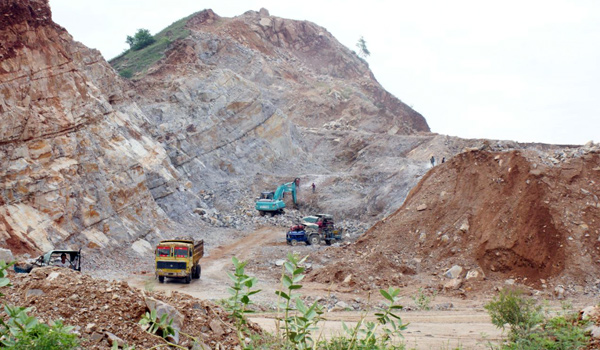Rajasthan CM, Bhajan Lal Sharma on Thursday directed officials to crackdown on the “mining mafia” in the state by conducting a five-day operation. Chairing a meeting of the mines and geology department here, he said preventing illegal mining, especially of gravel, is the priority of his government. Only strict and effective action will curb illegal mining in the state, Sharma stressed.
He directed that a five-day joint campaign by police, district administrations, forest department, transport department and mines department be conducted to take strict action against the “mining mafia”. Drones and other modern technology should be used to check illegal mining in the state, Sharma said.
The chief minister also directed that a task force be formed under the chairmanship of the chief secretary to prevent illegal mining. Only when strict enforcement of the law is ensured, there will be fear among those involved illegal mining, Sharma said. He directed district superintendents of police to take strict action against perpetrators.
Chief Minister Sharma has stressed the importance of conducting mining operations legally, particularly for riverbed sand mining. This type of mining requires a scientific replenishment study and environmental clearance from the Ministry of Environment and Forest. Following the Supreme Court’s directive, environmental clearance has already been granted to 60 mining areas in the state’s riverbeds as of February 2022.

The Chief Minister said officials should ensure that mining across the state is done according to rules. He also gave instructions to auction mining leases regularly.
Officials of the mines department must send regular reports regarding illegal mining and present a report on the action taken in the last 10 days, Sharma said. Chief Secretary Sudhansh Pant and Director General of Police UR Sahoo were among those present at the meeting.
Rajasthan’s upending illegal mining woes
Unregulated legal mining and rampant illegal mining in Rajasthan has systematically destroyed forests, devastated the Aravallis, and played havoc with the water resources of the state, says Centre for Science and Environment’s Sixth State of India’s Environment report, “Rich Lands, Poor People” – Is sustainable mining possible?
Extensively researched and richly illustrated, this 350-page report has been prepared as a state-of-art tome on mining in India, its impacts on environment and people, and the way ahead. CSE’s ‘State of India’s Environment’ reports have been widely acknowledged as the most comprehensive and authoritative series of publications on the subject of environment and development in India.
The report on mining lives up to that reputation and the promise. It details the issues of mining in different states of the country – including Rajasthan – the impacts on environment and people, and policy reforms that are essential to practice more ‘sustainable’ mining.
What kind of minerals does Rajasthan have?
Rajasthan has the highest number of mine leases in the country – 1,324 leases for major minerals, 10,851 for minor minerals and 19,251 quarry licenses for mining stones. The state earned about Rs 590 crore royalty from major minerals like lead, zinc and limestone in 2004-2005. But the sector contributes only three per cent to the state’s revenue.
Rajasthan holds reserves for 44 major and 22 minor minerals and is the only producer of garnet, jasper, selenite, wollastonite and zinc concentrates. It is also the leading producer of calcite, lead concentrate, ball clay, fireclay, ochre,
phosphorite, silver and steatite. But it is best known for its production of marble, sandstone, marble and other stones. It produces 10 per cent of the world’s and 70 per cent of India’s output of sandstone. Ajmer, Bhilwara, Bikaner, Dungarpur, Jaipur, Pali, Rajsamand, and Udaipur are its main mining districts.
Rajasthan’s regulations about mining
Rajasthan’s Aravallis slaughter
Mining in the Aravallis region of Rajasthan has led to soil erosion, groundwater depletion, and flooding of riverbeds. Despite being notified as an ecologically sensitive area in 1992, mining has continued unabated despite Supreme Court orders and threats. Marble slurry dumped on land adversely affects productivity, water absorption, and water percolation.

Chittorgarh city is getting choked due to marble slurry being dumped in abandoned mines, making groundwater unfit for drinking and cooking. The limestone mines of Chittor have breached the region’s water table, causing acute water scarcity and recession in the groundwater table. The slurry is carried away to rivers, drains, and local water bodies, affecting the quality of water, reducing storage capacities, and damaging aquatic life.
Is efficient and sustainable mining possible in Rajasthan?
Mining is not sustainable due to finite ore bodies and environmental footprints. However, it is necessary. The issue is how to conduct mining in an environmentally and socially acceptable manner. The report recommends policy initiatives such as recognising people’s right to say no, independent EIA reports, forest mining, stronger mine closure regulations, and doing more with less.
Review of Oil Refinery Project in Rajasthan
During a meeting with the Mines and Geology Department, the progress of the oil refinery project being built at Pachpadra in the Barmer district was also reviewed. The completion of this major project is expected by March 2025. However, the estimated cost of the oil refinery project has ballooned since its inception, with the current estimate standing at an eye-watering ₹72,937 crore. Notably, Prime Minister Narendra Modi had inaugurated the commencement of the refinery’s construction in 2018.
In summary, the Rajasthan government is stepping up its enforcement against illegal mining activities. Through stringent measures, technological advancements, and regular regulation of mining leases, the state aims to curb the exploitation of its natural resources. This initiative not only protects the environment but also ensures the legal and sustainable utilization of the state’s mineral wealth.












